The Meta Possibilities of Persona Q
The growing awareness and normalization of computer technology in the early 1980s created an obsessive fascination with the seemingly limitless technology. Science fiction in particular played a large role in stirring up ‘what if’ scenarios, and these stories often explored the connection or disconnection between technology and a sense of the soul and of spirituality.
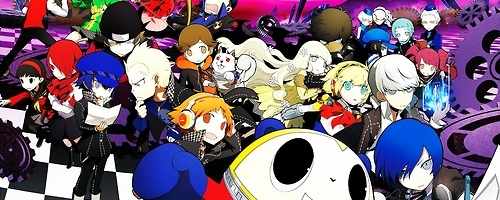
From 2001: A Space Odyssey’s epic search for God and seemingly sentient artificial intelligence, past the mind/body problem present in Do Androids Dream of Electric Sheep?, and up through the lurid cyberspace of Neuromancer, among countless others, the idea of technology as a vessel for the soul and spirit or as a portal through which the soul or spirit can travel through was a popular notion in speculative fiction, a notion that tugged on readers’ existential strings and made them wary of and worship the burgeoning technology.
A somewhat obscure Japanese pulp horror novel written by Aya Nishitani in 1986 would take this idea into a decidedly more occult and fantastic territory, foregoing existential qualms in favor of bombastic B-anime horror elements and grand visions of the future for radical and entertaining references to mythology and the arcane. That novel was Digital Devil Story: Megami Tensei, which would later spawn an entire video game franchise, Atlus’ Shin Megami Tensei, including its wildly successful spinoff series, Persona.
In the original novels and the subsequent games directly based on them, Megami Tensei I and II for the Japanese Famicom console, protagonist Akemi Nakajima, a gifted computer student, designs a Devil Summoning Program to actually summon demons into Nishitani’s vision of contemporary Japan. Computer hardware and software is used in these narratives as a portal into another realm of being, one of spirituality and mysticism, where demons and spirits emerge.
Nakajima created the software by seeing the similarities between computing languages and demonic symbols, a detail exposing the lack of understanding of computer technology which neither bothered the author nor, assumedly, the readers. This trend would continue in the game series.
Further into the Shin Megami Tensei games, there are other examples of contemporary technology opening gateways into the spirit world: Shin Megami Tensei on the Super Famicom features another iteration of the demon summoning program, designed by a fictional Stephen Hawking character after he discovers an opening to the demon world while developing an instantaneous travel method over a computer network.
Here, the technology is even more fantastic, and at one point, the characters’ mastery of spirituality and technology even allows them to enter a woman’s mind to defeat demons.
Megami Tensei features the COMP, a mini, portable computer, carried by many characters in the series to summon demons. Characters in Devil Survivor, released on the Nintendo DS, actually use COMPs that look and function like a Nintendo DS, effectively granting players an in-game weapon mirroring what’s actually in their hands. This detail transforms the player into a magical object holder, and allows her to, ever so slightly, transcend her humdrum life.
These sort of self-referential qualities could easily detract from the game’s narrative by reading as goofy, overly blatant, or worse, inconsistent with the game’s world, but Devil Survivor manages its grim yet brightly colored anime world well, almost reminiscent of a more apocalyptic Digimon Adventure.
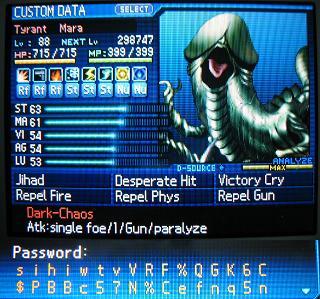
It wasn’t until Strange Journey that players could use actual technology, in the form of passwords, to share and summon demons over the internet or in person. Players could fuse demons and generate a string of characters which could then be input into another copy of the game to share the unique demon.
This “outside of the game” meta quality of monster summoning in video gaming had been seen before in the likes of Monster Rancher, which allowed players to put music CDs in their PlayStation to generate in-game monsters, but Shin Megami Tensei has a rich narrative background of summoning demons through technology that gives these actions an extra poignancy.
Persona Q: Shadow of the Labyrinth, a spinoff of Persona 3 and Persona 4, takes the idea of password summoning to another level by introducing QR codes to the game. Rather than generating a string of characters, players can generate a specific QR code that holds an entire demon’s being (level, statistics, skills, etcetera).
The Nintendo 3DS can scan and read the QR code, summoning that particular demon (in Persona Q, demons are called ‘Personas’) into another copy of the game. This may seem like a minute gameplay detail, but its implications are far reaching.
An entire community of players has grown around collecting and maintaining these codes, a veritable network of online digital devil librarians and occultists. These players’ roles in the game become their roles in real life, collecting sacred glyphs to summon demons, or rather, to “save the world.” By participating in this meta reality, they are directly participating in the actual myth that is the game, with each individual’s role being an important factor.
Generated QR codes are more than just game passwords as they are unrecognizable to the human brain, transcending mere letters and numbers and becoming an almost mystical and certainly magical glyph or ritual symbol, a technological feat and an interesting game mechanic. The codes function as the pentagrams and other demonic ritual symbols seen on Shin Megami Tensei promotional art, but also function as ‘actual’ portals into the demon realm.
This bit of meta-narrative and meta-gameplay enriches Persona Q, adding another layer and texture to the game’s already complex player experience. While not a mainline Shin Megami Tensei game that focuses on summoning demons through technology, Persona Q’s system is the closest that a Shin Megami Tensei game comes to fully realizing the world presented in Nishitani’s novel. Players generate demonic code through computer technology, which is then used to generate actual demons in the game’s (the player’s) world.
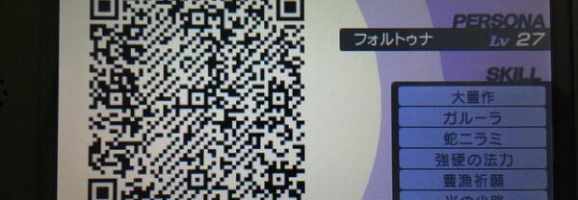
With all this talk of summoning RPG demons and video game Satanist rituals, one cannot help but be recalled to the early days of the popularization of Pokémon in North America, when certain media outlets claimed, with a dose of ethnocentrism, that the games were portals of sin and that Pokémon was anti-Christian propaganda.
Compared to Pokémon, the Shin Megami Tensei games are obviously heavier in tone and atmosphere, geared toward a slightly more mature audience and grounded in a more real setting. These games are more nuanced, too, and often present players with difficult, blurred lines of morality that challenge a status quo good versus evil.
The ‘demons’ of Shin Megami Tensei consist not only of the likes of Satan, Beelzebub, and Puzuzu, but range from Judeo-Christian angels (Michael, Gabriel, Uriel) to Japanese (Take-Mikazuchi, Kikuri-Hime, Arahabaki) and Chinese mythology (Seiten Taisei), Hindu (Sarasvati, Shiva), Balinese (Barong, Rangda), and draw from several other myths, regions, and lore (Oberon, Titania, Siegfried, Loa, Atlas).
The purpose of demon summoning in Shin Megami Tensei is not simply to bring evil unto earth, but to connect to a higher level of reality, to transcend a bit of oneself into the spiritual and supernatural realm. In these narratives, this is achieved through technology, whether in-game or, even better, in the player’s own physical reality.
When players connect with each other, swapping and cataloguing codes, they, possibly unknowingly, enhance the game’s narrative for themselves and their peers. Players begin to live the game, rather than just play it. That connection is subtle, and very real, special even.
– – –
Thus far, Persona Q has achieved the best meta-narrative/gameplay compromise with its sharable and scannable QR codes. As technology continues to both advance and become more readily available, the Shin Megami Tensei games can only become more concise and visceral in this regard. The series, and many other games, hold great promise in terms of utilizing future technology to create unique, creative, and strange experiences among players.
As you read this, somewhere, a fellow demon summoner rides on a subway, scans into her Nintendo 3DS a demonic glyph she researched on her smartphone, her COMP, and summons the demon to fight alongside her, just as Akemi Nakajima did before her thirty years ago.
What do you think? Leave a comment.





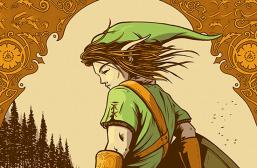

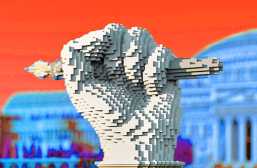
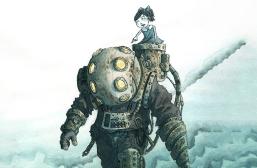


Fact. It is against the law for a Persona game to be bad.
I love Persona, but the 1st person combat is a deal breaker. It kills the essence of combat IMO. I like seeing attacks play out from both sides, not just watching a slash across the screen with number popping up to indicate damage. Seems like lazy combat design honestly.
It’s sort of like Dragon Quest IX if you’ve played that – while the field’s in a sort of first person view while you’re inputting the commands for the turn, the characters show up when they physically attack (admittedly, they fade out afterwards) and the camera zooms out when a skill is used, showing the person summoning their Persona.
I’ve missed the persona series so much since I got rid of my vita. I wish they would come out with a new persona game for ps4.
Have you seen the P5 trailer? Looks sick.
This is one of my new favorite games. I love how they brought back the cast of the third and fourth game… esp the fourth game (*squeal* yuki and chie!!!) The combat is still as fun as ever.
I really really want to know more about Persona 5. I think these spin off titles are great but I just want to play Persona 5 so much
I really need to play a Persona game.. they look so good. I’ve seen some of the movies but I’ve always wanted to play the games
I highly recommend P4 for newcomers to the series. It’s a bit more contemporary than 3, though 3 is probably the best…though, if you want my real recommendation, forgo Persona and go play SMT Nocturne or Strange Journey ; )
Great article, can’t wait to try out the game!
Persona + Catherine = yay or nay?
Hell yeah. I haven’t even played Catherine very much, but I love the world – one of Atlus’ best.
Good read. You sound passionate about gaming and with good knowledge!
I just got my premium edition. I love the game so far!
Too much combat in PQ.
I’m really disappointed I’ve never been able to get into this series. I tried persona 4 and it felt more like a goofy anime show with boring characters than an actual game.
It bothers me how the persona universe went from a dark intriguing universe, not too far removed from the Megami Tensei umbrella to… this.
I’ve admittedly only played Persona 4 Golden, but that certainly didn’t feel very dark. Sure, what was happening wasn’t exactly pleasant, but when it was couched around cliché high school drama it didn’t have a very dark tone.
I love Persona so much, in Atlus we trust!
Atlus: Keeping it real since 87.
I’ve loved this game since the moment it got announced!
This game looks great, and I’d love to try it out, but I just want to know one thing: what’s this like for newcomers? I’ve never played a Persona game myself.
Hey, I imagine you would not like it too much. A lot of the dialouge refers to events in the past games and I find myself laughing because I loved those games so much. Character development is slightly predicated upon the player being familiar with them already. I would say, DO YOURSELF A FAVOUR as a gamer, and play Persona 4 Golden.
Every time I see an article about a Persona game I get one step closer to buying a handheld.
Beautiful game!
A must buy game for 3DS Persona 3 and 4 on crack…….great game play.
In effect a bar code for a video game… I can see the attraction in the real world.